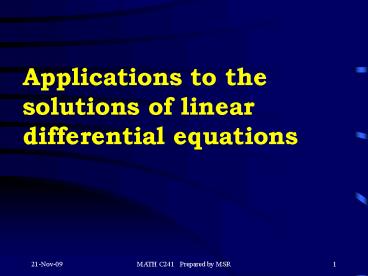Applications to the solutions of linear differential equations - PowerPoint PPT Presentation
1 / 54
Title:
Applications to the solutions of linear differential equations
Description:
Solve the initial value problem. 11/6/09. MATH C241 Prepared by MSR. 5. or ... Second Shifting Theorem. Suppose g(x) is piecewise continuous and is of ... – PowerPoint PPT presentation
Number of Views:1478
Avg rating:3.0/5.0
Title: Applications to the solutions of linear differential equations
1
Applications to the solutions of linear
differential equations
2
Applications to the solutions of linear
differential equations
Consider the second order constant coefficient
linear differential equation
with the initial conditions
We shall assume y?, f(x) are piecewise
continuous and are of exponential order.
3
Taking Laplace transforms on both sides we get
i.e.
or
4
Hence
provided we are successful in finding a function
y such that Ly R.H.S.
Problem 3(b) Page 394
Solve the initial value problem
5
Taking Laplace transforms on both sides, we get
or
Hence
6
Problem 6 Page 394 Solve
Taking Laplace transforms on both sides, we get
7
Hence
Hence
8
Further properties of Laplace Transforms
9
Further properties of Laplace Transforms -
First Shifting Theorem
If
then
Proof
10
Example
?
?
In terms of inverse Laplace transform, we can
thus write
11
Let us define the unit step function
Now if g(x) is a function defined for x ? 0, we
define the function f(x) ua(x) g(x-a) by
12
That is, f(x) is got by shifting g(x) a
units to the right and then annihilating the
portion to the left of a.
Second Shifting Theorem Suppose g(x) is
piecewise continuous and is of exponential order.
Let
f(x) ua(x) g(x-a)
Then
13
Proof
Put t x - a
14
Thus if
then
For example
Hence
15
Derivatives and Integrals of Laplace transforms
Theorem
If
then
Proof
Differentiating both sides w.r.t. p, we get
16
or
More generally
17
Example
Hence
Theorem
If
then
18
Proof
Let
Hence
i.e.
or
19
Thus
a a constant.
Now we want G(p) ? 0 as p ? ?. And this is got by
putting a ?.
Thus
20
Corollary
Thus
Letting p ? 0, we get
Application
21
Hence
And so
22
Theorem If f(x) is of exponential order and is
periodic with period a (i.e f(xa)f(x)), then
(pgt0)
Proof
23
In
put x t na. We get
Hence
p gt 0
24
Application Let f(x)1 in the intervals 0 to 1,
2 to 3, and f(x)0 in the remaining intervals.
Thus f(x) is periodic with period 2.
Thus
p gt 0
25
ProblemWe know y J0(x) is a solution of the
initial value problem
Taking Laplace transforms on both sides we get
or
or
Hence
26
Thus
Hence
for some constant c
Noting that
We get
c 1.
Hence
27
The convolution product of two functions
28
The convolution product of two functions
Definition If f(x), g(x) are two functions,
we define their convolution product f g by the
formula
For example if f(x)1, g(x)x, we get
Thus 1 x x2/2 (and not x)
29
Theorem The convolution product is
commutative that is, f g g f Proof
put x-t u,
Theorem The convolution product is associative
i.e. (f g) h f (g h).
30
Theorem If f(x), g(x) are piecewise continuous
and are of exponential order, then Lf g
Lf Lg (ordinary product) Proof
Changing the order of integration, we get
31
t
The line t x
x
32
put x-t u,
Hence
33
Thus
34
Applications of Convolutions to the solutions of
Initial Value Problems
35
More about convolutions Suppose we wish to solve
the I.V.P
satisfying the initial conditions
We first solve the above equation when
36
where
We denote the solution of (1) with f(t) u(t) as
A(t).
Hence
Taking Laplace transforms on both sides, we get
37
or
where
Now consider the general problem
38
Taking Laplace transforms on both sides, we get
Hence
39
Hence
We used the fact
where
and so
40
Hence
Applying Leibnizs rule for differentiating
integrals we get
41
Again
gives
Hence
42
putting t s u
We get y
Also y
as A(0)0
Thus the general solution y can be expressed in
terms of A(t), the solution to
43
Problem 4(a) Page 410 Solve
For this, we first solve
where u(t) is the unit step function.
44
Denoting the solution by A(t), we find (on taking
Laplace transforms and simplifying) that
45
Therefore
Thus
46
Second Method
47
Diracs Delta function
48
Diracs Delta function (? Unit Impulse function)
Let ? gt 0 be a positive constant. We define the
function f? (x) by saying
49
1/?
Graph of f? (x)
?
We note that
50
We also find that
If we denote by
51
We find that ?(x) is such that
Also
52
Thus ?(x) is NOT an ordinary function (for any
function which is zero at all but a finite number
of points will have its integral also 0).
We say that ?(x) is a generalized function.
It is called Diracs Delta function (named after
the famous Physicist Paul Dirac).
It is also referred to as the unit impulse
function.
And we note that its Laplace transform is 1.
53
If x represents time and f? (x) force, then
represents the impulse of the
force f? (x) acting over the time interval (0,
?).
Hence as ? ? 0, we may speak loosely of a
resulting unit impulse at x 0 due to an
infinite force acting for a very small time
interval. In view of this interpretation, the
limiting form of f? (x) is frequently called the
54
the unit impulse function.
We can similarly define ?(x - a) ( a gt 0), the
Diracs Delta function centred at a.
Question What is the Laplace transform of ?(x -
a) ?
End of Laplace Transforms

